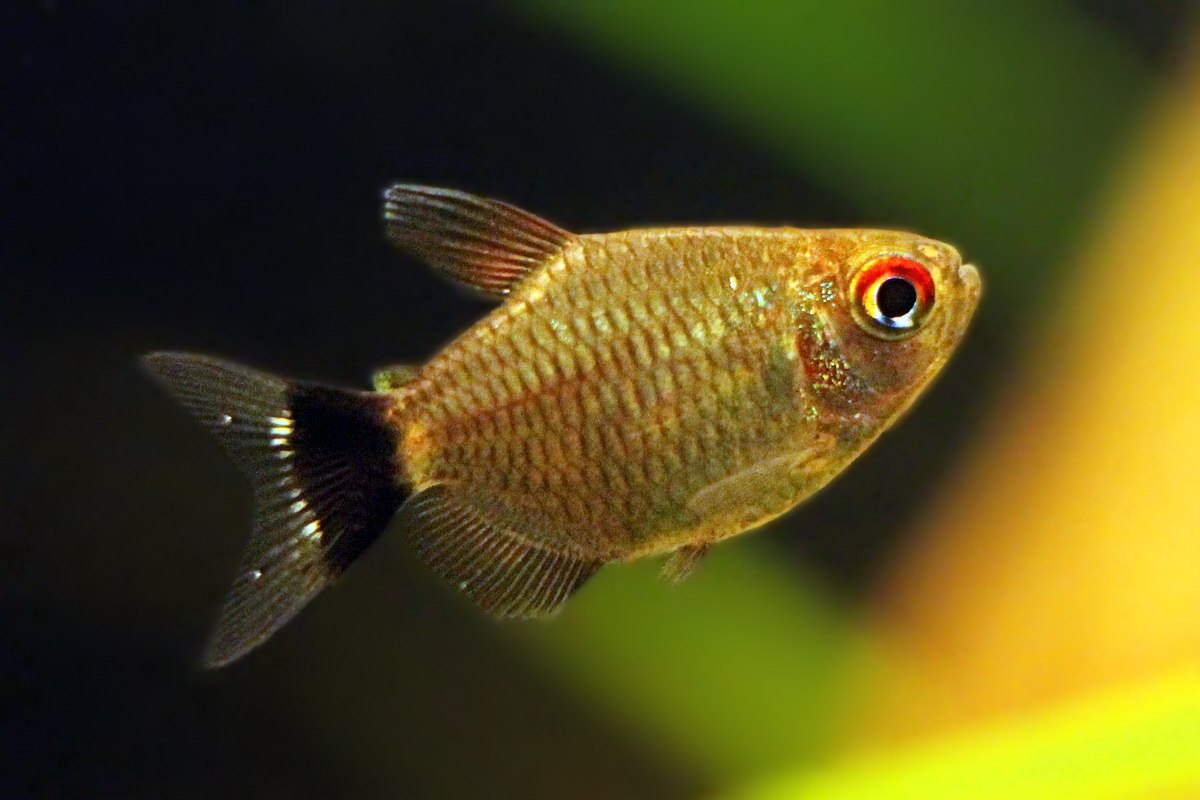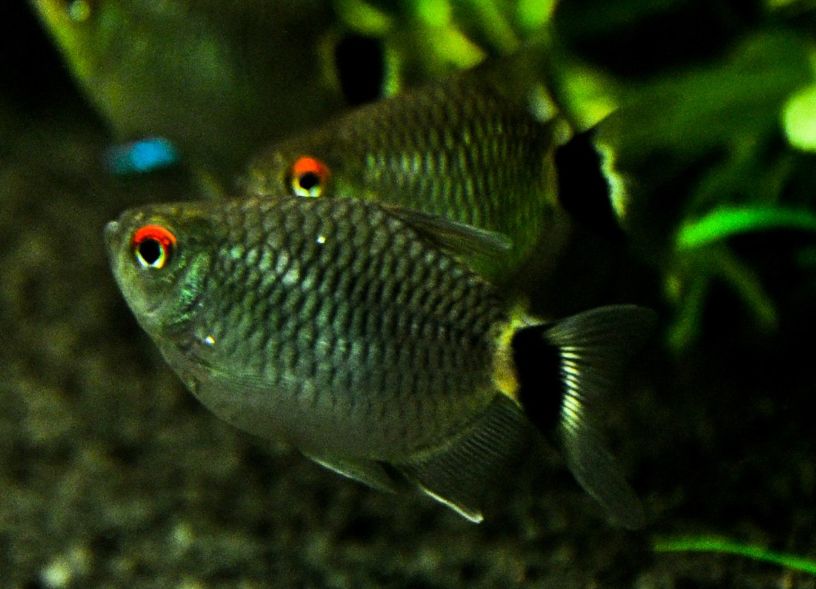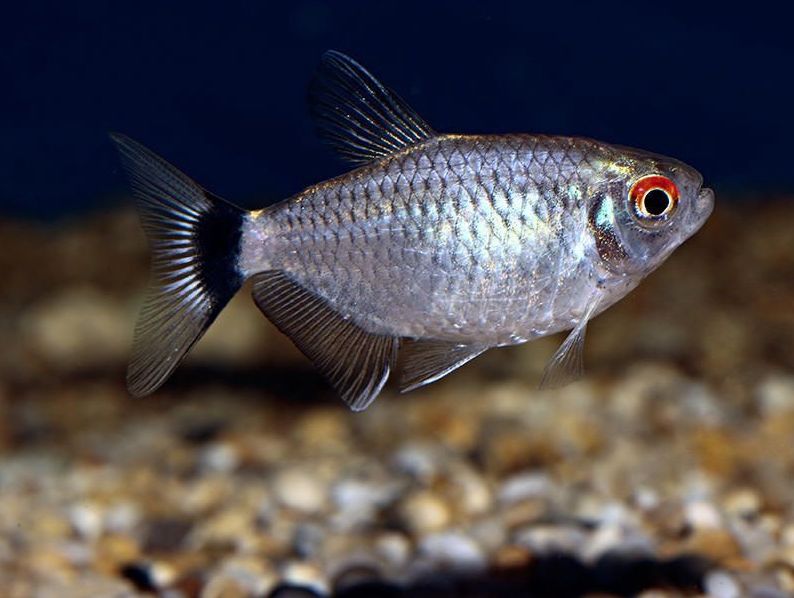Red eye tetra (lat. Moenkhausia sanctaefilomenae) once was the most spread and common tetras in a tank. A school of these characins can make any tank look nice and lively, but nowadays the fish has yielded the palm to other fishes. Is a peaceful active fish, quite easy in care. This fish needs to be in the school much more unlike it’s relative redeye tetra. Regardless of how many of them are in a tank: three, eight or twenty species – they always swim in a school.

Contents
Habitat in the wild
Red eye tetra belongs to the family Characidae. Characidae is a large family of freshwater fish that includes many popular aquarium species, such as tetras, piranhas, hatchetfish, and pencilfish. These fish are mostly found in South America, but some species can also be found in other parts of the world.
Red eye tetra was first described in 1907. Moenkhausia sanctaefilomenae is native to South America, specifically found in various river systems across countries like Brazil, Argentina, and Paraguay. In the wild, they inhabit slow-moving and heavily vegetated waters such as streams, rivers, and flooded areas with dense aquatic vegetation, but sometimes it may swim to tributaries to search for feed in thick plants there. This is a schooling fish and it feeds on insects.
| Characteristic | Description |
|---|---|
| Scientific Name | Moenkhausia sanctaefilomenae |
| Common Name | Red Eye Tetra, Lamp eye tetra, Monk tetra |
| Family | Characidae |
| Origin | South America (Brazil, Argentina, Paraguay) |
| Adult Size | Approximately 2 to 2.5 inches (5 to 6 cm) |
| Lifespan | 3 to 5 years or longer with proper care |
| Behavior | Peaceful, shoaling fish; prefers to swim in schools |
| Tank Size | Minimum 20 gallons for a small group |
| Water Temperature | 72°F to 82°F (22°C to 28°C) |
| pH Range | 6.0 to 7.5 |
| Water Hardness | Soft to moderately hard (dGH 5 to 15) |
| Tank Region | Middle to top levels of the aquarium |
| Diet | Omnivorous; accepts flake, pellet, and live/frozen foods |
| Compatibility | Generally peaceful, suitable for community tanks |
| Tank Level | Middle to top levels of the aquarium |
| Water Flow | Prefer slow-moving water |
| Lighting | Moderate to low lighting levels |
| Breeding | Egg-scatterer; requires spawning mops or dense plants |
| Sex Differences | Males may have more intense coloration and smaller size |
Description
Size
Moenkhausia sanctaefilomenae typically reaches an adult size of approximately 2 to 2.5 inches (5 to 6 centimeters) in length. Males and females are generally similar in size, but males may appear slightly smaller and more slender than females. As with most fish species, there can be some variation in size among individuals, but this is the typical size range for adult red eye tetras in the aquarium hobby.
Lifespan
On average, Red Eye Tetras typically have a lifespan of about 3 to 5 years in a well-maintained aquarium. However, with excellent care and favorable conditions, they may live even longer, potentially reaching up to 5 to 7 years.
Body
It has a sleek and elongated body shape, typical of most tetra species. The body is slightly compressed from the sides, giving it a streamlined appearance.
Exists two types red eye tetras known to aquarists:
- red eye tetra
- balloon red eye tetra
Balloon red eye tetra it is smaller and it has more wide than long body, so it looks more rounded. Balloon fish often have a rounded or bloated appearance due to abnormal or excessive fluid retention in their body, particularly in the swim bladder area. These varieties are usually not natural or healthy for the fish and may come with various health issues and reduced lifespan.
Coloration
The Red Eye Tetra’s body is silver or silvery-gold in color, with a reflective sheen that catches light beautifully. Its most distinctive feature is the bright red or orange-red eye, which stands out prominently against the silver body.

Difficulties in keeping
Care is easy since it’s not a demanding fish, so it’s good for beginner. As we’ve already mentioned – the red eye tetra is active, peaceful and if it is a balloon species, it also keeps the school well. Red eye tetra has a very social behavior and it prefers swimming in schools of 5-6 fishes.
Care and keeping in a tank
Tank size
The tank size for red eye tetras depends on the number of fish you plan to keep. These tetras are social and prefer to swim in schools, so it’s essential to keep them in groups of six or more to ensure their well-being and reduce stress.
For a small group of red eye tetras (about 6 to 8 individuals), a minimum tank size of 20 gallons (75 liters) is recommended. This size will provide enough space for them to swim comfortably and allow for some plants and decorations to create a suitable environment.
However, keep in mind that larger tanks are generally better for fish, as they offer more stable water conditions and allow for better filtration. If you plan to keep a larger school of red eye tetras or want to include other fish species in the same aquarium, you should consider a larger tank to accommodate their needs.
Water parameters
Recommended water parameters for red eye tetras:
- Temperature: 72°F to 82°F (22°C to 28°C) – Red Eye Tetras are tropical fish and thrive in a moderately warm environment.
- pH Level: 6.0 to 7.5 – They prefer slightly acidic to neutral water conditions. Monitoring the pH regularly is essential to ensure stability.
- Water Hardness: Soft to moderately hard – A general hardness (GH) level between 5 and 15 degrees is suitable for Red Eye Tetras.
- Ammonia and Nitrite: 0 ppm – Ammonia and nitrite are toxic to fish. Make sure to keep these levels at zero by cycling your tank properly and performing regular water changes.
- Nitrate: Below 20 ppm – Nitrate is a less toxic byproduct of the nitrogen cycle, but high levels can still be harmful to fish. Regular water changes will help keep nitrate levels in check.
- Filtration: A good filtration system is crucial to maintaining water quality. It helps remove debris and harmful substances, ensuring a healthy environment for the fish.
- Water Flow: Red eye tetras prefer slow-moving water. Avoid strong currents that might stress them.
Decor
Creating a suitable and visually appealing aquarium decor for red eye tetras (Moenkhausia sanctaefilomenae) involves mimicking their natural habitat while providing them with places to explore, hide, and feel secure. Here are some decor ideas that can enhance their environment:
- Aquatic Plants: Red eye tetras come from habitats with abundant aquatic vegetation. Consider adding live plants such as Amazon swords, Java ferns, or Anubias to the aquarium. Plants not only provide hiding spots for the fish but also contribute to improved water quality.
- Driftwood and Rocks: Adding driftwood and rocks can create additional hiding places and break up the swimming space, providing a more natural-looking environment. The tetras may use these features as shelter, and they can also serve as anchor points for plants.
- Floating Plants: Some floating plants, like water lettuce, can help diffuse the lighting and create shaded areas in the aquarium. This can be beneficial for the tetras, as they are accustomed to moderate to low lighting levels in their natural habitat.
- Substrate: A sandy or fine-grained substrate can mimic the riverbed or stream bottom where red eye tetras are often found. A natural-colored substrate will complement the overall look of the aquarium.
Lighting
In the wild the fish habitat doesn’t have a lot of light, because the shores of the rivers have lots of greenery. It’s better if the tank has soft lighting which can be achieved by putting some floating plants on the water.
Tank mates
The red eye tetra is good for community tanks at the condition that it’s kept in a school. However, they may scare more calm fishes, since it’s very active, so you just have to choose the same active tank mates for it.
For example, it can be black skirt tetra, emperor tetra, cardinal tetra. Also tetra may nip other fishes fins, so don’t keep them with long-finned fishes or other slow fishes with large fins, for example, with angelfishes.
If there’s no such possibility, you may smooth this kind of the fish behavior by keeping it in a school where the fishes have an hierarchy and they become busy with the species of their kind.
Diet
Red eye tetras are omnivorous fish and have a versatile diet. In the wild, they feed on a variety of foods, including small insects, zooplankton, algae, and plant matter. In an aquarium setting, it’s essential to provide them with a balanced diet to ensure their health and vitality.
Here are some suitable foods for red eye tetras:
- High-quality flake or pellet food: A staple diet of high-quality flake or pellet food specifically designed for tropical fish can serve as the primary food source. Look for products that contain a variety of nutrients and are suitable for small community fish.
- Live and frozen foods: Red Eye Tetras will relish live or frozen foods like brine shrimp, bloodworms, daphnia, and mosquito larvae. These foods mimic their natural diet and provide essential proteins and nutrients.
Remember to feed your red eye tetras in small portions multiple times a day rather than one large feeding. This feeding pattern mimics their natural behavior and ensures that they have continuous access to food throughout the day.
It’s essential to avoid overfeeding, as excess food can lead to water quality issues. Monitor your fish’s behavior and adjust their diet as needed to keep them healthy and active. A well-balanced diet will enhance their natural colors and promote their overall well-being in the aquarium.
Gender differences: male vs female
In Moenkhausia sanctaefilomenae, it can be challenging to distinguish between males and females based solely on external characteristics, especially when they are not in breeding condition. The differences between males and females are generally subtle and become more apparent during the breeding season.
Here are some general guidelines that might help in identifying male and female red eye tetras:
- Size: In some cases, females can be slightly larger and more robust than males, but this difference may not always be significant.
- Coloration: During the breeding season, male may exhibit more intense coloration, particularly around their fins and body. They might appear brighter and more vibrant than females.
- Body Shape: Males might have a slightly more streamlined and elongated body compared to females. Females might appear slightly plumper, especially when carrying eggs.
- Fins: In some cases, males might have slightly more extended or pronounced dorsal and anal fins compared to females. However, this distinction can be subtle and not always reliable for identification.
- Behavior: During the breeding season, males may display more active and assertive behavior, particularly when courting females.
It’s important to note that these differences can be challenging to spot in young or non-breeding red eye tetras. If you are interested in having a male and female pair for breeding purposes, the best approach is to observe their behavior during the breeding season. The male will often chase the female and engage in courtship behaviors, such as flaring fins and displaying vibrant colors.

Breeding
Red eye tetra become reproductive approximately at the age of 10 month. Breeding should take place in a separate tank from 2 gallons capacity, covered from top.
It should also have some Java moss or a separating grid on the bottom. The tank water should be warmer (24-28 °C), acidic (6-6,8) and soft (до 6°). Before spawning you should prepare the fishes: put them is a separate tanks, feed well and add some plant food into the diet.
The fishes that were put into spawning tank in the evening start their mating game within the tank plants in the morning. The female lays up to 1000 sticky eggs that lay on the tank bottom or get stuck on the plants leaves.
At the end of spawning period the fishes are removed from the tank and you should start light aeration in it. The fish is very fruitful. The eggs incubation time is about 1-2 days. On the 5-6th day larva become juveniles and they start feeding on small nauplii of brine shrimp.
The juveniles are very small from the beginning, therefore the brine shrimp should be small correspondingly, the same concerns cyclops nauplii, rotifers or infusorian. Juveniles grow slowly even despite well balanced and high diet.